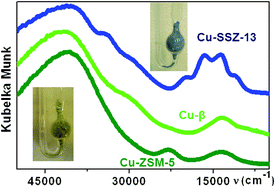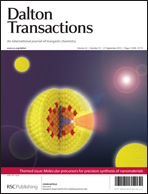Cu-SSZ-13 has been characterized by different spectroscopic techniques and compared with Cu-ZSM-5 and Cu-β with similar Si/Al and Cu/Al ratios and prepared by the same ion exchange procedure. On vacuum activated samples, low temperature FTIR spectroscopy allowed us to appreciate a high concentration of reduced copper centres, i.e. isolated Cu+ ions located in different environments, able to form Cu+(N2), Cu+(CO)n (n = 1, 2, 3), and Cu+(NO)n (n = 1, 2) upon interaction with N2, CO and NO probe molecules, respectively. Low temperature FTIR, DRUV-Vis and EPR analysis on O2 activated samples revealed the presence of different Cu2+ species. New data and discussion are devoted to (i) [Cu–OH]+ species likely balanced by one framework Al atom; (ii) mono(μ-oxo)dicopper [Cu2(μ-O)]2+ dimers observed in Cu-ZSM-5 and Cu-β, but not in Cu-SSZ-13. UV-Vis-NIR spectra of O2 activated samples reveal an intense and finely structured d–d quadruplet, unique to Cu-SSZ-13, which is persistent under SCR conditions. This differs from the 22 700 cm−1 band of the mono(μ-oxo)dicopper species of the O2 activated Cu-ZSM-5, which disappears under SCR conditions. The EPR signal intensity sets Cu-β apart from the others.

You have access to this article
 Please wait while we load your content...
Something went wrong. Try again?
Please wait while we load your content...
Something went wrong. Try again?


 Please wait while we load your content...
Please wait while we load your content...